Metal vs Tile Roof Cost: Full Pricing Breakdown

When it’s time to replace or install a roof, one of the most critical factors influencing your decision is cost—but understanding the metal vs tile roof pros and cons is equally important for long-term value. If you’re comparing metal vs tile roof cost (or wondering about metal roof vs tile roof cost for short), you’re likely looking for real numbers, practical guidance, and long-term value—whether you’re a homeowner in a hurricane-prone area or a commercial property manager planning a major upgrade.
This article offers a straightforward, side-by-side breakdown of the cost of metal vs tile roofing, helping you confidently move forward with the right option for your property and budget, helping you confidently move forward with the right option for your property and budget.
Here’s what you’ll find inside:
- Cost Overview – Metal vs Tile Roof at a Glance
- Material Costs – Metal vs Tile
- Labor & Installation Complexity
- Maintenance, Longevity & Value Over Time
- Regional & Environmental Cost Influences
- Cost Planning – Financing & Affordability Options
- Which Roof Type Is More Affordable for You?
Let’s start by looking at how the average installation costs of metal and tile roofs compare at a glance.
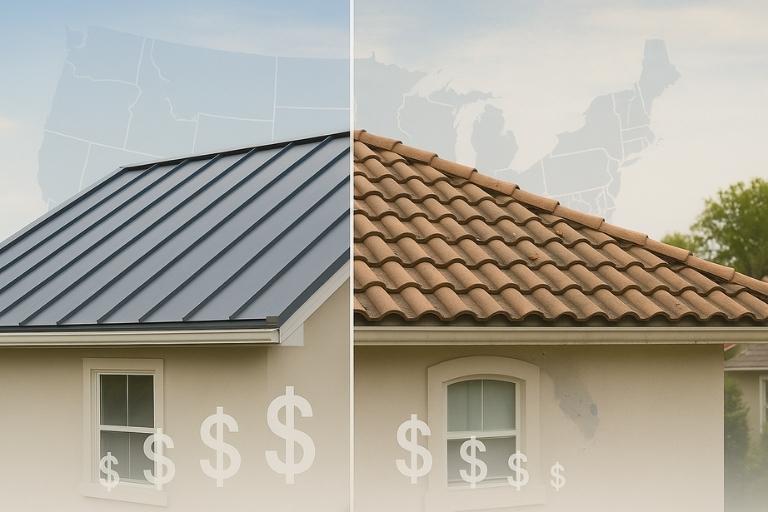
Why Roof Cost Comparison Matters
Installing or replacing a roof is one of the most significant investments a property owner will make—whether you’re a homeowner preparing for storm season in Florida or a commercial property manager maintaining multiple facilities across 17 states. With costs often ranging from tens to hundreds of thousands of dollars, the decisions you make upfront can have long-term financial consequences.
That’s why understanding the true tile roof vs metal roof cost—beyond surface-level estimates—is essential to making a smart, confident choice.
The cost of a roof isn’t just about materials. It’s a sum of many factors, including:
- Installation labor and time
- Structural requirements (e.g., weight support for tile)
- Maintenance and repair expectations
- Lifespan and total return on investment
- Regional factors like weather resistance or local building codes
For example, a tile roof may have a longer lifespan in calm climates but can require expensive structural reinforcement or higher labor costs in hurricane-prone zones. Conversely, a metal roof might cost more upfront but offer long-term savings in energy efficiency and minimal maintenance—particularly attractive for property managers trying to avoid downtime or costly repairs.
If you’re a homeowner, you may be weighing roofing options due to recent storm damage, an aging roof system, or plans to boost energy efficiency. You want to know which material fits your budget now—and won’t surprise you with extra costs later.
If you’re a commercial property owner or manager, your concerns may also include business interruption, long-term maintenance contracts, or compliance with building codes and insurance guidelines.
In either case, transparency matters. You need more than vague price ranges—you need realistic expectations based on your property type, region, and project scope. This guide is here to help you do exactly that.
Takeaway: A thorough tile roof vs metal roof cost comparison is more than just a pricing exercise—it’s a crucial step toward choosing the roofing system that aligns with your financial goals, building needs, and long-term peace of mind.
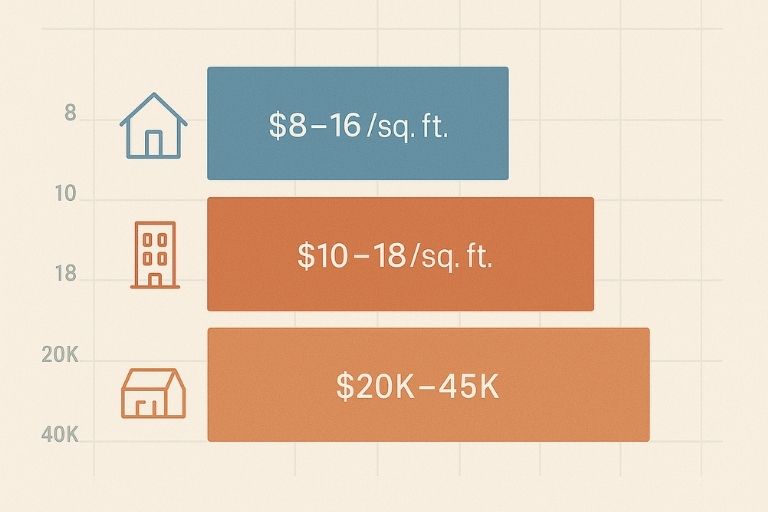
Cost Overview – Metal vs Tile Roof at a Glance
Before diving into the details, let’s establish a clear baseline: how much does it actually cost to install a metal or tile roof? Understanding the average price range—both per square foot and in total—can help you quickly gauge which option may better align with your budget.
While tile roof cost vs metal roof cost per square foot can vary widely depending on factors like location, roof complexity, and labor rates, we can provide reliable ballpark figures based on current industry trends across residential and commercial projects — for a more granular view, see our roof cost per square foot breakdown.
Average Installation Costs (Per Square Foot and Total Range)
Below is a general estimate of typical roofing costs:
- Metal Roofing:
- Residential: $8 – $14 per sq. ft.
- Commercial: $7 – $12 per sq. ft.
- Total installation: $16,000 – $28,000+ for an average 2,000 sq. ft. home
- Residential: $8 – $14 per sq. ft.
- Tile Roofing (Clay or Concrete):
- Residential: $10 – $18 per sq. ft.
- Commercial: $9 – $16 per sq. ft.
- Total installation: $20,000 – $36,000+ for an average 2,000 sq. ft. home
- Residential: $10 – $18 per sq. ft.
Keep in mind, these figures reflect standard conditions. High-end material selections (e.g., copper for metal or handmade clay for tile), complex roof designs, or extensive prep work (like removing old roofing or reinforcing structural supports) can drive up total costs significantly.
Quick Comparison Table (Metal vs Tile Roofing Costs)
| Cost Category | Metal Roofing | Tile Roofing |
| Material Cost (per sq. ft.) | $4 – $8 | $6 – $10 |
| Installation Labor (per sq. ft.) | $4 – $6 | $4 – $8 |
| Typical Total (Residential) | $16K – $28K+ | $20K – $36K+ |
| Commercial Range (per sq. ft.) | $7 – $12 | $9 – $16 |
| Avg. Lifespan (for context) | 40–70 years | 50–100 years |
Note: These estimates apply to standard installations. Regional labor rates, structural complexity, and required upgrades (like hurricane strapping or underlayment changes) can alter final pricing.
Whether you’re managing a retail center or planning a roof replacement for your home, these base numbers give you a realistic starting point. If you’re still comparing broader roofing options, check out our updated guide to roof replacement costs in 2025 for national pricing benchmarks. In the next sections, we’ll unpack what drives those numbers up—or keeps them in check—depending on your roofing material of choice.
Next up: Let’s break down the actual material costs—or jump straight to a full breakdown of metal vs tile roof costs for a side-by-side comparison.
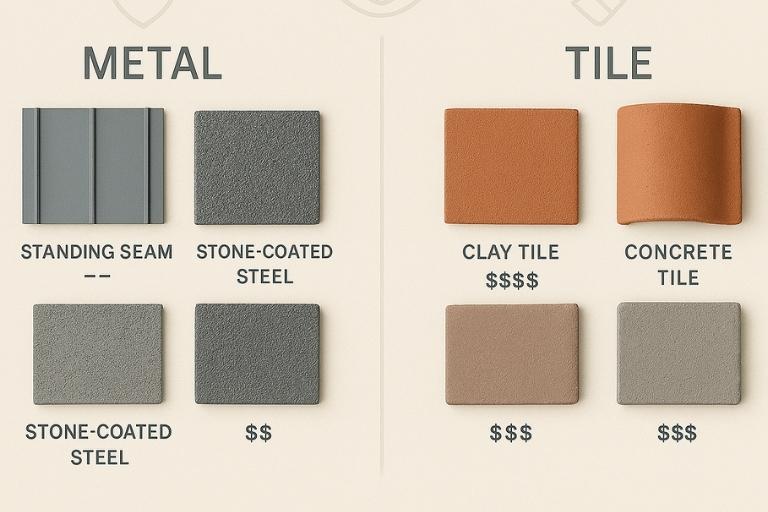
Material Costs – Metal vs Tile
When comparing metal vs tile roof cost, one of the biggest influences on your budget is the type of material you select. Both metal and tile roofs come in a variety of options, each with its own price point—explore the average cost of roofing materials to better understand your pricing tiers. Understanding these differences can help you prioritize what matters most—be it upfront cost, durability, or visual impact.
Types of Metal Roofing (Aluminum, Steel, Copper)
Metal roofing offers a wide range of choices, from budget-friendly panels to premium architectural styles. The material you choose will significantly affect your overall cost.
- Aluminum
- Cost: $4 – $7 per sq. ft.
- Lightweight, corrosion-resistant, and good for coastal areas
- Cost: $4 – $7 per sq. ft.
- Galvanized Steel
- Cost: $3.50 – $6 per sq. ft.
- Durable and cost-effective, common in residential and commercial applications
- Cost: $3.50 – $6 per sq. ft.
- Standing Seam Metal Panels
- Cost: $6 – $10 per sq. ft.
- Sleek, modern look with concealed fasteners; less maintenance
- Cost: $6 – $10 per sq. ft.
- Copper
- Cost: $12 – $20+ per sq. ft.
- High-end, long-lasting, and visually striking—typically used in luxury or historic projects
- Cost: $12 – $20+ per sq. ft.
In general, When comparing metal roof vs concrete tile roof cost, metal tends to offer more budget flexibility at the entry level, but costs can rise quickly with upgraded finishes or complex profiles.
Types of Tile Roofing (Clay, Concrete, Composite)
Tile roofing is best known for its timeless aesthetic and long lifespan, with many types of tile roofing offering unique blends of cost, durability, and appearance.
Like metal, it comes in a variety of material types, each with its own pricing considerations—including niche options like metal tile vs clay tile roof cost comparisons that emulate the barrel look without the weight.
- Concrete Tile
- Cost: $4 – $6 per sq. ft.
- Most affordable tile option; durable but heavy
- Cost: $4 – $6 per sq. ft.
- Clay Tile
- Cost: $7 – $12 per sq. ft.
- Classic look, excellent for hot climates; higher material and installation cost
- Cost: $7 – $12 per sq. ft.
- Composite or Synthetic Tile
- Cost: $6 – $10 per sq. ft.
- Lighter weight alternative, designed to mimic real clay or slate; easier to install
- Cost: $6 – $10 per sq. ft.
Because of their weight, most tile materials may require additional structural reinforcement, which adds to the overall project cost.
Material Cost Comparison – Quick Reference
| Roofing Material | Estimated Cost (per sq. ft.) | Notes |
| Aluminum (Metal) | $4 – $7 | Lightweight, corrosion-resistant |
| Steel (Metal) | $3.50 – $6 | Durable and widely used |
| Standing Seam Metal | $6 – $10 | Premium, clean look, low maintenance |
| Copper (Metal) | $12 – $20+ | Luxury aesthetic, exceptional longevity |
| Concrete Tile | $4 – $6 | Economical, heavy, long-lasting |
| Clay Tile | $7 – $12 | Classic and durable, costly to install |
| Composite Tile | $6 – $10 | Lighter weight, modern mimicry of traditional tile |
Takeaway: When evaluating metal tile vs clay tile roof cost, remember that the material alone can account for up to 50% of your total roofing cost. Choosing the right one depends on your budget, property needs, and design preferences—each option carries its own trade-offs in price and performance.
Next, we’ll explore how labor and installation complexity factor into your overall roofing cost.
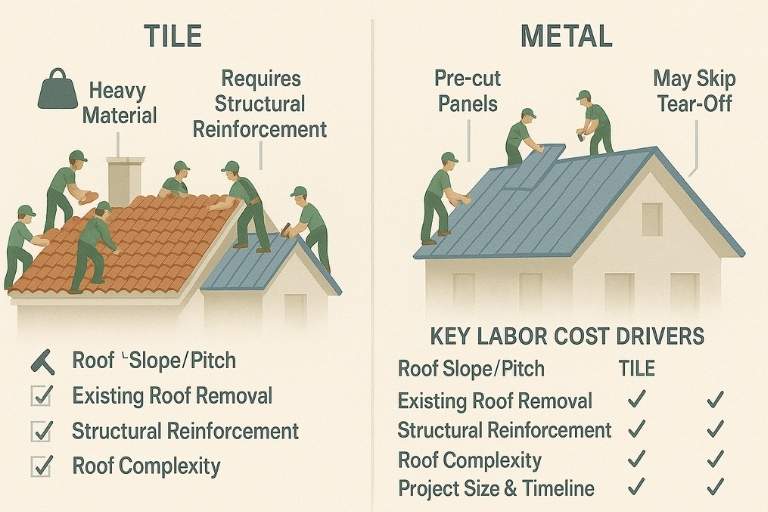
Labor & Installation Complexity
Material costs are just one side of the roofing equation—the other major factor is labor. Labor and installation can account for 30–50% of your total roofing cost, depending on the material, roof design, and regional labor rates.
When comparing metal vs tile roof cost, understanding how installation complexity affects your bottom line is key—but it’s also important to weigh factors like durability, aesthetics, and energy efficiency. Our metal vs tile roofing comparison guide explores these key differences.
Why Tile Roofing Often Costs More to Install
Tile roofs—especially clay and concrete—are significantly heavier than metal roofing systems. That added weight often requires:
- Reinforcing the roof structure, particularly in older homes or buildings
- More labor-intensive handling and placement due to individual tiles
- Longer installation timelines, often several days or even weeks depending on project scale
This translates to higher labor costs per square foot. Installers must take extra time to ensure correct alignment, secure each tile, and work around design features like chimneys or valleys. On complex roof designs, these added challenges can increase installation labor by 20–30% compared to metal roofing.
How Metal Roofing Can Reduce Labor Time and Cost
Metal roof installation cost vs tile roof often shows noticeable differences, with panel-based systems like standing seam or corrugated requiring less time and fewer workers. Panels can be custom-cut off-site and installed in large sections, minimizing on-site adjustments. In many cases, metal roofs can even be installed directly over existing shingles (if local codes allow), eliminating tear-off costs.
This efficiency not only lowers the metal roof installation cost vs tile roof labor costs but can also reduce business disruption for commercial properties and shorten the timeline for weather-sensitive projects.
Key Labor & Installation Cost Drivers
Here’s a checklist of common factors that influence labor costs for both metal and tile roofs:
- Roof Slope/Pitch – Steeper roofs increase labor time and safety requirements
- Existing Roof Removal – Tearing off old materials adds labor and disposal fees
- Structural Reinforcement – Required for heavier tile systems
- Roof Complexity – Multiple ridges, valleys, skylights, or HVAC vents add installation time
- Project Size & Timeline – Larger or expedited projects typically cost more per square foot
Takeaway: Tile roofs may offer long-term durability, but their labor-intensive installation process often makes them the more expensive choice upfront. Metal roofs, by contrast, can help control labor costs and reduce timelines—advantages that benefit both residential and commercial projects.
Next, we’ll look at how maintenance needs and roof lifespan affect overall value.
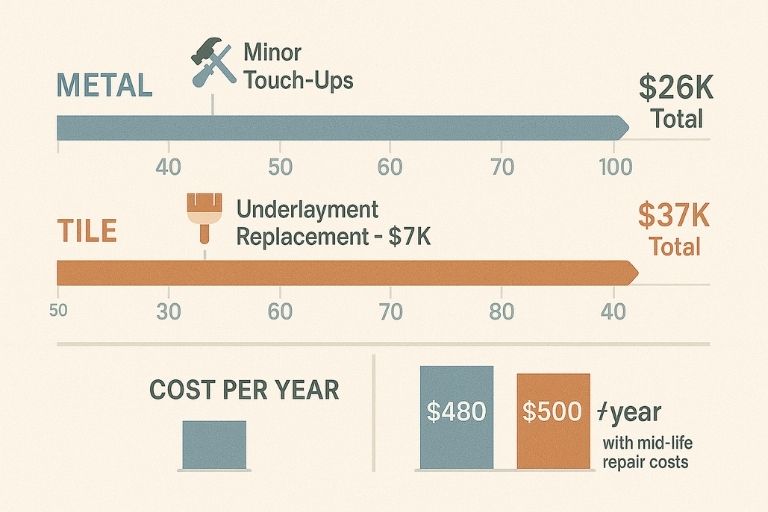
Maintenance, Longevity & Value Over Time
While upfront installation costs are important, savvy property owners also look at how roofing materials perform over decades—not just years. When comparing metal vs tile roof cost, it’s crucial to factor in long-term value: how much maintenance each material requires, how long it lasts, and what it really costs you over time.
Lifespan of Each Roof Type and Associated Long-Term Costs
Both metal and tile roofs are known for their durability, but a closer look at metal roofing vs clay tile durability reveals important differences in maintenance and lifespan.
- Metal Roofing
- Lifespan: 40–70 years, depending on material (steel, aluminum, or copper)
- Maintenance: Minimal; may require occasional fastener tightening, sealant reapplication, or paint touch-ups over time
- Typical Issues: Dents from hail, minor corrosion if protective coatings degrade
- Estimated Long-Term Maintenance Cost: Low to moderate, averaging $0.20 – $0.50 per sq. ft. annually
Consider preventive services like roof coatings or periodic roof inspections to extend metal roof life even further.
- Lifespan: 40–70 years, depending on material (steel, aluminum, or copper)
- Tile Roofing (Clay or Concrete)
- Lifespan: 50–100 years for clay; 30–50 years for concrete
- Maintenance: Moderate; tiles can crack or shift, and underlayment may need replacement after 20–30 years
- Typical Issues: Tile breakage, underlayment wear, moss buildup in humid regions—many of which can be managed with regular tile roof maintenance tips.
- Estimated Long-Term Maintenance Cost: Moderate to high, averaging $0.40 – $0.80 per sq. ft. annually
- Lifespan: 50–100 years for clay; 30–50 years for concrete
While tile roofs may have the edge in sheer lifespan, their heavier structure and layered assembly often mean higher maintenance and repair costs over time—especially in storm-prone or humid areas.
What’s the Better ROI?
When evaluating roofing ROI, consider cost per year of service. A metal roof installed for $24,000 with a 50-year life span works out to $480 per year. A tile roof installed for $30,000 lasting 60 years averages $500 per year—but this doesn’t include periodic underlayment replacement or more frequent maintenance.
Example Scenario:
A Florida homeowner installs a concrete tile roof for $30,000. After 25 years, they spend another $7,000 on underlayment replacement. Total 50-year cost: $37,000.
By comparison, a standing seam metal roof costs $24,000 upfront, with minimal upkeep. Over 50 years, even with $2,000 in touch-up maintenance, the total cost is $26,000.
Framing the Value
- Metal Roofs: Lower ongoing costs, fewer repairs, consistent long-term savings
- Tile Roofs: Excellent longevity, but higher maintenance and mid-life repair investments
- Commercial Takeaway: Metal offers strong ROI for property managers prioritizing minimal disruption and predictable upkeep
- Residential Takeaway: Tile’s classic appeal and longevity may justify the cost—if you’re prepared for the long-haul maintenance
Takeaway: While both metal and tile roofs offer long lifespans, metal typically delivers better cost control over time. For homeowners and commercial clients alike, looking beyond the sticker price can reveal significant long-term value.
Next, we’ll examine how environmental and regional factors can influence roofing costs.
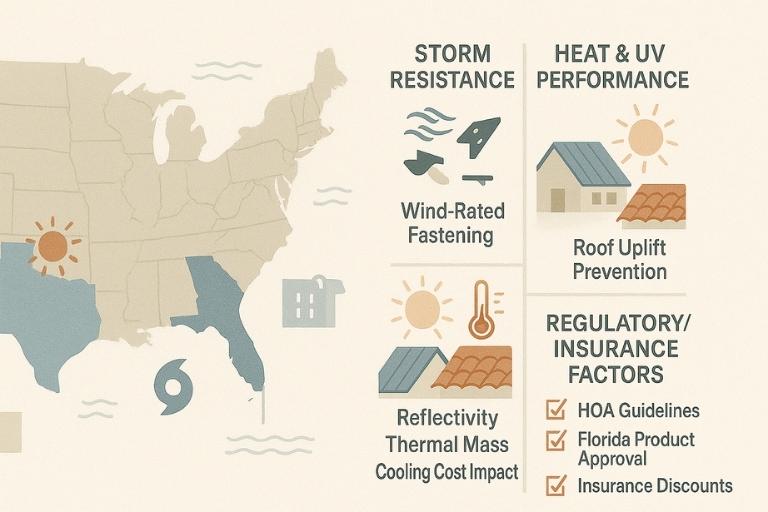
Regional & Environmental Cost Influences
Where your property is located plays a major role in roofing costs—both in material selection and the overall scope of work. In regions like Florida and other parts of the Southeast, environmental and regulatory factors can significantly influence your decision between a metal or tile roof. When evaluating metal vs tile roof cost, it’s essential to account for how local climate, building codes, and insurance policies affect pricing and performance.
Hurricane-Prone Areas
Florida is a prime example of a region where roofing decisions must factor in extreme weather. High winds, torrential rain, and flying debris demand roofing systems that are:
- Wind-resistant, often rated to withstand gusts of 120–150 mph or more
- Impact-resistant, particularly in areas susceptible to hail or falling branches
- Securely fastened, to prevent uplift or water intrusion
Metal roofing, especially standing seam systems, tends to perform exceptionally well under these conditions due to its interlocking panels and minimal seams. It’s also lightweight, reducing the risk of structural stress during a storm.
Tile roofing, while durable, is heavier and can be more vulnerable to wind uplift if not installed correctly. In hurricane zones, clay or concrete tiles often require additional fastening systems or reinforcement, which can increase labor and material costs. Wind Damage Repair services are often needed after major weather events in such cases.
Heat Exposure and Sun Intensity
In high-sun areas like Florida, Texas, or Arizona, roofing systems must also stand up to prolonged UV exposure and heat. Reflective metal roofs often outperform darker tile materials in this regard, contributing to energy efficiency and potentially lowering cooling costs—though this benefit varies depending on the building’s insulation, design, and metal roof color longevity.
Tile roofs, especially clay, naturally resist heat and offer strong thermal mass, which plays a major role in tile roof vs metal roof energy efficiency comparisons. However, color fading and surface wear can be accelerated by intense sun, possibly increasing maintenance over time.
Building Codes and HOA Guidelines
Many municipalities—particularly in Florida—have strict building code requirements for roofing. These may mandate:
- Specific wind uplift ratings
- Hurricane straps or underlayment types
- Fire-resistance ratings
- Material approval under Florida Product Approval (FPA) or Miami-Dade County standards
In addition, Homeowners Associations (HOAs) may dictate the type, color, or material style allowed in residential communities. Tile roofs are often favored in Mediterranean- or Spanish-style neighborhoods, while metal may require HOA approval even if it meets all structural codes.
Insurance and Roofing Costs
Insurance providers in storm-prone regions increasingly factor roofing material into coverage costs and deductibles. Some offer discounts for impact-resistant or wind-rated roofs, making metal an attractive long-term choice. Conversely, damaged tile roofs—while repairable—can result in higher insurance claims due to material cost and replacement complexity.
Takeaway: Environmental conditions and local codes can significantly affect both the cost and suitability of metal or tile roofing. For properties in high-risk zones like Florida, choosing a compliant, storm-ready system may mean added upfront costs—but can offer peace of mind, lower insurance premiums, and better performance when it matters most.
Next, let’s look at how financing and affordability options can help you plan smarter.
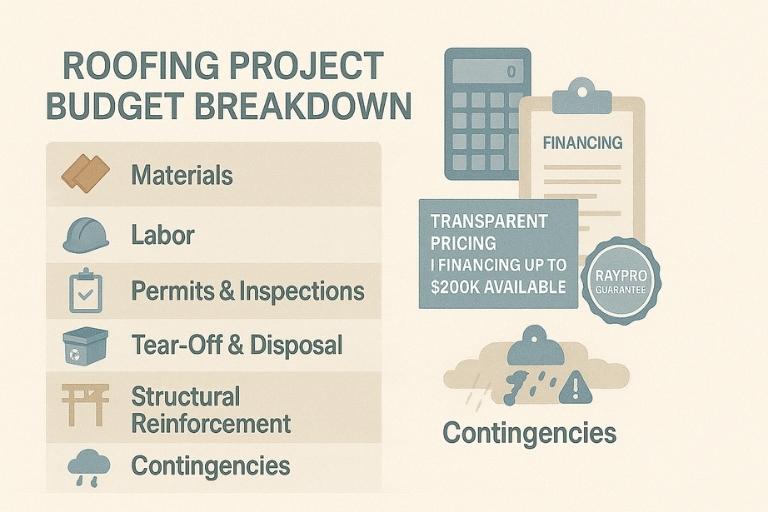
Cost Planning – Financing & Affordability Options
A new roof is a significant investment, and proper cost planning can make the difference between a stressful project and a smooth experience. Whether you’re replacing an aging residential roof or managing upgrades across a commercial portfolio, it’s important to approach roofing projects with a clear understanding of budget, financing options, and the total cost of ownership.
Budgeting for a Major Roofing Project
The total cost of a roof includes more than just materials and labor. Your budget should account for:
- Permits and inspections (required in most municipalities)
- Tear-off and disposal fees (if removing old roofing)
- Structural reinforcements (often needed for tile installations)
- Underlayment and flashing upgrades
- Contingencies (unexpected repairs or weather delays)
Because costs can vary based on region, property size, and roof complexity, it’s crucial to request an itemized quote before signing any contract. A detailed breakdown helps you evaluate whether you’re paying for quality materials, fair labor rates, and essential services—or being upsold on unnecessary extras.
RayPro’s Transparent Pricing Approach
One of the biggest concerns property owners face is unexpected charges. RayPro addresses this by offering 100% transparent pricing, with detailed proposals provided before any work begins. There are no hidden fees—just honest, upfront costs that reflect the scope and quality of the job.
RayPro also offers flexible financing solutions, including plans of up to $200,000 for qualifying projects. These financing options help spread out the cost of your roof investment, making it easier to move forward with needed upgrades without compromising on quality or safety. Visit our Contact Us page to learn more or request a quote.
Affordability Considerations for Homeowners and Commercial Clients
- Homeowners can benefit from low monthly payments, especially when replacing a storm-damaged roof or upgrading for energy efficiency.
- Commercial property managers may use financing to align roof investments with capital improvement budgets or lease agreements.
- In both cases, financing helps preserve cash flow while addressing urgent roofing needs proactively.
Get the roofing or renovation solution your property needs today without the upfront burden.

Takeaway: Budgeting with clarity and exploring financing options are critical steps in managing roofing costs. With transparent pricing and tailored financing solutions, you can make a well-informed decision that aligns with your timeline, cash flow, and long-term property goals.
Next, we’ll help you evaluate which roofing material may be more affordable based on your specific situation.
Which Roof Type Is More Affordable for You?
By now, it’s clear that affordability isn’t just about the lowest upfront price—it’s about how well your roofing choice fits your property, local climate, long-term plans, and budget strategy. Both metal and tile roofing have their advantages, but which one makes more financial sense for you depends on several key factors.
Let’s break it down.
Affordability Depends On:
- Your Property Type:
- Single-family homes with moderate roof slopes may be more suited to tile or metal, depending on structural readiness.
- Commercial or multi-family buildings often lean toward metal for easier, faster installs and lower maintenance.
- Single-family homes with moderate roof slopes may be more suited to tile or metal, depending on structural readiness.
- Your Region & Weather Conditions:
- In hurricane-prone zones like Florida, metal roofing’s wind resistance and lighter weight can reduce structural stress and insurance risk.
- In dry, hot climates, clay tile performs well thermally but may require stronger support framing and costlier repairs over time.
- In hurricane-prone zones like Florida, metal roofing’s wind resistance and lighter weight can reduce structural stress and insurance risk.
- Your Long-Term Goals:
- If you plan to stay in the home or own the building for 30+ years, consider long-term maintenance and ROI.
- If you’re seeking budget-friendly repairs or quick improvements, initial cost and ease of installation may weigh more heavily.
- If you’re also planning for energy efficiency, consider pairing your new roof with solar panel installation for additional long-term savings.
- If you plan to stay in the home or own the building for 30+ years, consider long-term maintenance and ROI.
Roof Affordability Checklist
Use this checklist to determine which roofing type aligns with your needs:
| If you… | Then consider… |
| Want lower upfront cost | Metal or Concrete Tile |
| Need a faster, simpler installation | Metal |
| Live in a high-wind/hurricane-prone area | Metal (standing seam preferred) |
| Prefer a classic, high-end appearance | Clay or Composite Tile |
| Have a roof that requires structural reinforcement | Metal (lighter and easier to install) |
| Value low long-term maintenance | Metal |
| Plan to stay in the property for decades | Tile or High-Grade Metal |
| Need to match HOA or architectural style | Tile (clay or concrete) |
Metal roofing often wins on installation speed, long-term savings, and climate resilience—key reasons many property owners ask, is metal roofing better than tile?
Tile, while more expensive upfront, delivers exceptional curb appeal and long lifespan—particularly when the structure and budget can support it.
The best roofing option depends on more than just material price—it’s about how those materials perform under your property’s conditions and your long-term financial goals.
Ready to explore roofing options tailored to your needs? Reach out to RayPro Roofing & General Contracting for a customized, transparent estimate.
FAQs About Metal vs Tile Roofing Costs
When it comes to choosing between metal and tile roofing, there are a few questions that come up time and again. Below are clear, concise answers to help you make an informed decision based on cost, longevity, and performance.
Often, yes—especially on installation. While premium metals can be pricey, metal typically avoids structural reinforcement and installs faster, reducing overall project cost compared with many clay tile systems.
As a general rule, asphalt shingles cost less upfront than tile but have a shorter lifespan. If you’re cross-shopping beyond metal vs tile, this context helps explain overall roof tiling costs versus standard shingles.
For stone-coated or stamped metal “tiles,” expect metal tile roof cost in the range of $6–$12 per sq. ft. (materials), with installed totals varying by roof complexity and region.
Stamped or stone-coated tiles can be similar to entry standing seam materials; final pricing depends on profile, coating, and trim packages.
Ask about stone-coated profiles that mimic barrel tile. They keep weight low and can offer a competitive cost—just one reason why choose metal tile roofs over traditional clay.
